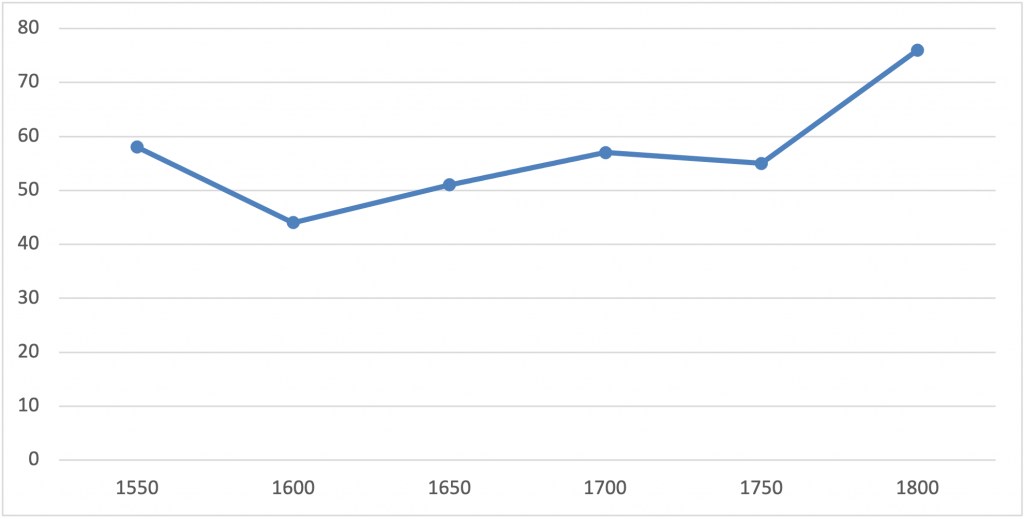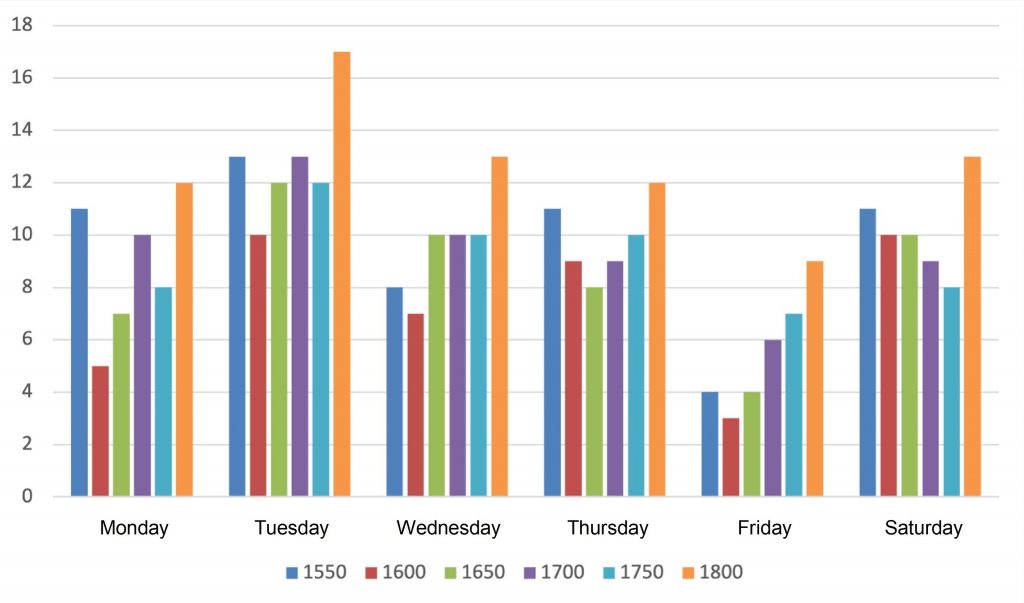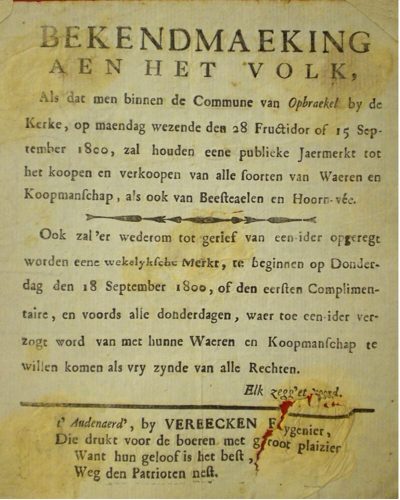MARKETS IN FLANDERS THROUGH THE EARLY MODERN PERIOD
DETAILS
Used database:
Date:
Category:
Author: Wouter Ronsijn
The Ghent flower market celebrates its 250th anniversary this year and is probably the oldest flower market in Flanders. Apparently, flowers were first sold on Ghent’s Kouter square by the horticulturalist Toontje Verstuyft in 1772 on the first Sunday in June.
Until the late twentieth century, local weekly markets played a central role in the economic and social life of village and urban dwellers. In those days, people could buy not only flowers but also a wide variety of products. Wouter Ronsijn (UGent) has used the STREAM database to reconstruct the development of weekly markets in the county of Flanders between ca. 1550 and 1800. Where could people go? And on which days?
Weekly, monthly and annual markets
For centuries, local markets played a central role in the economic and social life of village and urban dwellers. We have put together an overview of all the places in the county of Flanders that had an official or unofficial market between 1550 and 1800, based on market applications and rights, official surveys and summaries compiled in the STREAM database. These were physical markets: gatherings of buyers and sellers at specific places and times. The word ‘market’ comes from the Latin mercatus. Male and female farmers came there to sell food (such as grain, potatoes, butter, eggs, poultry) or raw materials (such as flax, kemp, oilseeds). Vendors came to the market with consumer goods (pots, pans and so on), and butchers and fishmongers also often sold their wares there. Weekly markets were more focused on selling goods for daily use (food but also raw materials). Monthly markets often served to sell livestock, while annual markets offered a wider range of consumer goods or hosted large horse markets. Ghent had one of the oldest annual markets, the so-called Bamisfoor, which was held on 1 October to mark the feast of Saint Bavo. This fair is said to go back to the ninth or tenth century. In the Middle Ages, the annual markets of Torhout, Lille, Ypres, Messines and Bruges formed a cycle of successive fairs, with each one lasting a month. In the Duchy of Brabant, the annual markets of Antwerp and Bergen-op-Zoom were the most important. These physical gatherings at specific places and times provided a practical solution for helping buyers and sellers find each other. Trade always involves two parties, and markets bring those parties together. Moreover, markets made trade more transparent because they offered insights into supply and demand and so influenced prices.
Number of weekly markets
According to some sources, Count Baudouin III established weekly markets in Bruges, Kortrijk, Torhout and Roeselare in 958. This would make them among the oldest markets in Flanders, but today historians doubt whether this claim is correct. The origins of the first markets in Flanders are shrouded in mystery. Nevertheless, it is probably true that several Flemish markets have their roots in the High Middle Ages (1000-1250) or earlier. As the population of Flanders increased and trade grew, so did the number of markets in the long run. According to the historian Peter Stabel, sixteenth-century Flanders was a region with many cities and market centres and several new centres were added in that century.
We have enough sources to follow this evolution numerically, starting from the early modern period. We examined which places had a weekly market for six points in time (1550, 1600, 1650, 1700, 1750 and 1800), and on which day of the week the market (or the main market) took place. This shows that around 1550, with almost 60 markets, Flanders already had a dense market network (see Graph 1). In the second half of the sixteenth century, however, the number of markets declined sharply, in the wake of the economic disruption and demographic losses at the beginning of the Eighty Years’ War (1568-1648). Around a quarter of all markets had disappeared by around 1600, and it took until around 1700 for Flanders to once again have about as many markets as it held around 1550. The growth in the number of markets was especially strong after the middle of the eighteenth century. Between 1750 and 1800, more than 20 markets were added, so more than a third of the number of existing markets. In the nineteenth century, this number increased even further. Around 1868, the provinces of East Flanders and West Flanders had no fewer than 110 markets. However, due to the rise of retail trade and supermarkets, most markets disappeared in the course of the twentieth century.

Friday (no) market day?
In the early modern period, the markets were rather evenly spread over the different weekdays, except that there were no markets on Sundays and few on Fridays (see Graph 2). In the Middle Ages, there were still several places with a Sunday market, such as Assenede and Stekene, but they were moved at some point. There were exceptions, such as the markets for birds, flowers and potatoes that were held on Sundays in Ghent ca. 1800. The fact that there were few markets on Fridays may have had to do with the sobriety inspired by the Catholic rule of not eating meat on that day. However, it may also have had to do with the fact that Friday was the main market day in Ghent. The city of Ghent did not tolerate any competing markets on that day and new marketplaces probably did not want to compete with Ghent either. When establishing new markets, people often chose days when there were no other markets being held in the area. As the Flemish market network grew denser, more and more markets were added on Fridays.

Official and unofficial
It is likely that many official markets evolved from older informal markets, established without the impetus of the local government. Local authorities had various reasons for giving such informal markets an official character. Recognition contributed to the security and stability of the market. In this way, the market no longer had to continue hiding in the shadows of public spaces. The safety of market visitors was sometimes explicitly guaranteed in the rights by which they were recognised. In addition, this recognition made it easier for the government to monitor the trade that took place there. Official recognition of markets, and the prohibition of trade outside them, made it possible to inspect the quality of the merchandise, gain a better insight into the supply to towns and villages, take note of (and possibly influence) the prices at which goods were sold, and to control the weights and measures used for making calculations.
Moreover, taxes could then be levied on market trade, which in turn was a reason for buyers and sellers to avoid official markets and meet elsewhere, on the informal circuit. Official recognition was also sought to make it easier for inhabitants to buy raw materials or food, or to sell their products and to support the activities of innkeepers and shopkeepers, who saw a part of the profits made at the market immediately spent at their establishments. In addition, a market also gave a village prestige.
However, economic or fiscal considerations were not the only factors that played a role in the creation of markets. Markets and fairs were not just places where goods were traded or taxes levied. They also provided an opportunity for entertainment, for spreading news or rumours, and for protest and conflicts. For farmers, market day was not only the day on which money could be made from the sale of agricultural products, it was also the day on which people went to town in their Sunday best to hear the latest news or to buy fashionable new items. Notaries were also busier on market days. Many people came together at successful markets, which could pose a threat to public order. Sometimes the somewhat moralising objection was made, especially when fairs were established, that these were days of drunkenness and idleness.
Putting together the above overview was not a straightforward task and what has been presented here cannot claim to be complete. The case of Opbrakel is a good example of the difficulties in constructing the overview. In a survey from the early 1800s, the mayor of Opbrakel stated that his municipality did not have a market. An attempt a few years earlier to establish a market was met with resistance from the neighbouring marketplaces of Nederbrakel and Geraardsbergen, and came to nothing because the central government did not grant permission. This permission had been necessary since the Middle Ages, until it was abolished in 1870. But in fairness, the mayor did admit in the same survey that the inhabitants of his village usually gathered every Thursday, including in inns, to trade small goods among themselves for the needs of their families.

It was an unofficial market without permission from the central government (Source: Rijksarchief Gent, Scheldedepartement, 2315/5)
Was this a market then or not? Activities that could be considered markets took place outside officially recognised markets as well. These were sometimes genuinely informal markets that were at times tolerated and at other times opposed. Conversely, some official markets existed only on paper, while in reality they were hardly visited. However, we often know more about these official markets precisely because of their official character. In the next blog post we will show where these markets were located.
Sources
- UGent Quetelet Center, STREAM database.
Literature
- Blockmans, F., “L’équipement commercial de la Flandre avant 1300”, Annales de la Fédération archéologique et historique de Belgique, 1938, pp. 273-286.
- Carlier, J. J., “Origine des foires et des marchés publics en Flandre”, Annales du Comité Flamand de France, 1861-1862, 6, pp. 127-139.
- Stabel, Peter. De kleine stad in Vlaanderen. Brussels, Paleis der Academiën: 1995.
- Stabel, Peter. Dwarfs among giants. Leuven, Garant: 1997.
- Van Damme, Ilya. Verleiden en Verkopen. Amsterdan, Aksant: 2007.
- van Bavel, Bas. Manors and Markets. Oxford, Oxford University Press: 2010.
- van Houtte, J. A., “Les foires dans la Belgique ancienne”, La foire. Brussels, Éditions de la librairie encyclopédique: 1953, pp. 175-207.
- Viaene, Antoon, “Duizend jaar markt te Roeselare”, Biekorf, 1958, 59, pp. 369-372.
- Verhulst, Adriaan, “De vroegste geschiedenis en het ontstaan van de stad Gent”, Handelingen der Maatschappij voor Geschiedenis en Oudheidkunde te Gent, 1972, 26(1): 5-39.
- Ronsijn, Wouter. Commerce and the Countryside. Gent, Academia Press: 2014.
- For a recent overview, see www.markten.be and www.belgischemarkten.be
If you want to use one of the dataset mentioned above, do not hesitate to contact queteletcenter@ugent.be.